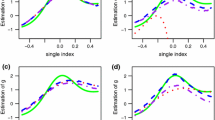Abstract
The functional single-index model is a very flexible semiparametric model when modeling the relationship between a scalar response and functional predictors. However, the efficiency of the model may be affected by non-normal errors. So, in this paper, we propose functional single index composite quantile regression. The unknown slope function and link function are estimated by using B-spline basis functions. The convergence rates of the estimators are established. Some simulation studies and an application of NIR spectroscopy dataset are presented to illustrate the performance of the proposed methodologies.


Similar content being viewed by others
References
Ait-saïdi A, Ferraty F, Kassa R, Vieu P (2008) Cross-validated estimations in the single-functional index model. Statistics 42:475–494
Attaoui S, Laksaci A, Said E (2011) A note on the conditional density estimate in the single functional index model. Statist Probab Lett 81:45–53
Cai T, Hall P (2006) Prediction in functional linear regression. Ann Stat 34:2159–2179
Cardot H, Crambes C, Sarda P (2005) Quantile regression when the covariates are functions. J Nonparametric Stat 17:841–856
Cardot H, Ferraty F, Sarda P (2003) Spline estimators for the functional linear model. Stat Sin 13:571–591
Chen D, Hall P, Müller H (2011) Single and multiple index functional regression models with nonparametric link. Ann Stat 39:1720–1747
Davino C, Furno M, Vistocco D (2014) Quantile regression: theory and applications. Wiley, New Jersey
Ferraty F, Keilegom I, Vieu P (2010) On the validity of the bootstrap in non-parametric functional regression. Scand J Stat 37:286–306
Ferraty F, Peuch A, Vieu P (2003) Modèle à indice fonctionnel simple. Comptes Rendus de I’Académie des Sci Ser I Math 336:1025–1028
Ferraty F, Vieu P (2006) Nonparametric functional data analysis: theory and practice. Springer, New York
Huang J, Horowitz J, Wei F (2010) Variable selection in nonparametric additive models. Ann Stat 38:2282–2313
James G (2002) Generalized linear models with functional predictors. J R Stat Soc Ser B Stat Methodol 64:411–432
Kato K (2012) Estimation in functional linear quantile regression. Ann Stat 40:3108–3136
Knight K (1998) Limiting distribution for regression estimators under general conditions. Ann Stat 26:755–770
Koenker R (2005) Quantile regression. Cambridge University Press, Cambridge
Koenker R, Bassett G Jr (1978) Regression quantiles. Econom J Econ Soc 46:33–50
Lei J (2014) Adaptive global testing for functional linear models. J Am Stat Assoc 109:624–634
Li Y, Hsing T (2007) On rates of convergence in functional linear regression. J Multivar Anal 98:1782–1804
Lian H (2011) Functional partial linear model. J Nonparametric Stat 23:115–128
Lu Y, Du J, Sun Z (2014) Functional partially linear quantile regression model. Metrika 77:317–332
Ma S (2016) Estimation and inference in functional single-index models. Ann Inst Stat Math 68:181–208
Ma H, Li T, Zhu H, Zhu Z (2019) Quantile regression for functional partially linear model in ultra-high dimensions. Comput Stat Data Anal 129:135–147
Müller H, Stadtmüller U (2005) Generalized functional linear models. Ann Stat 33:774–805
Reiss P, Goldsmith J, Shang H, Ogden R (2017) Methods for scalar-on-function regression. Int Stat Rev 85:228–249
Sang P, Cao J (2020) Functional single-index quantile regression models. Stat Comput 30:771–781
Shang H, Hyndman R (2013) Fds: functional data sets. University of Southampton. R package version 1.7. https://CRAN.R-project.org/package=fds
Schumaker L (2007) Spline functions: basic theory. Cambridge University Press, Cambridge
Tang Q, Cheng L (2014) Partial functional linear quantile regression. Sci China Math 57:2589–2608
Yu D, Kong L, Mizera I (2016) Partial functional linear quantile regression for neuroimaging data analysis. Neurocomputing 195:74–87
Yu P, Du J, Zhang Z (2020) Single-index partially functional linear regression model. Stat Pap 61:1107–1123
Acknowledgements
The authors would like to thank the Editor, Associate Editor and referees for their careful reading and insightful suggestions that lead to substantially improved the paper. The research was supported by the Humanities and Social Science Foundation of Ministry of Education of China [Grant Number 21YJA910004].
Author information
Authors and Affiliations
Corresponding author
Ethics declarations
Conflict of interest
On behalf of all authors, the corresponding author states that there is no conflict of interest.
Additional information
Publisher's Note
Springer Nature remains neutral with regard to jurisdictional claims in published maps and institutional affiliations.
Appendix. Proof of the main results
Appendix. Proof of the main results
Proof of Theorem 3.1
Let \(\theta =(\gamma ^{\top },\lambda ^\top )^{\top }\), \(\theta _0=(\gamma _0^{\top },\lambda _0^{\top })^{\top }\), \(\delta =n^{-\frac{d}{2d+1}}\), \(T_{1}=\delta ^{-1}(\gamma -\gamma _{0})\), \(T_{1}=\delta ^{-1}(\lambda -\lambda _{0})\) and \(T=(T_{1}^{\top }, T_{2}^{\top })^{\top }\). We next show that, for any given \(\epsilon >0\), there exists a sufficient large constant \(L=L_{\epsilon }\) such that
This implies with the probability at least \(1-\epsilon \) that there exists a local minimizer in the ball \(\{\theta _{0}+\delta T:\Vert T\Vert \le L\}\).
By the Knight’s identity (Knight 1998), we have
For \(A_2\), we have
Let \(u_0=\langle \varvec{X}_i(t),\varvec{\gamma }_0(t)\rangle \), using Taylor expansion to \(A_{21}\) and \(A_{22}\) at \((u_0,\lambda _0)\) respectively, by conditions (C1)-(C3), we have
Similarly, we can get \(A_1=O_p(n\delta )\Vert T\Vert \). Then, \(A_1+A_2=O_p(n\delta ^2)\Vert T\Vert ^2\) uniformly in \(||T\Vert =L\) when L is sufficiently large. Therefore, similar to Yu et al. (2020), (A.1) holds, and there exists local minimizers \(\hat{\gamma }\) and \(\hat{\lambda }\) such that \(\Vert \hat{\gamma }-\gamma _0\Vert =O_p(\delta )\) and \(\Vert \hat{\lambda }-\lambda _0\Vert =O_p(\delta )\). Then, similar to the argument in Yu et al. (2020), we can finish the proof of this theorem. \(\square \)
Rights and permissions
Springer Nature or its licensor holds exclusive rights to this article under a publishing agreement with the author(s) or other rightsholder(s); author self-archiving of the accepted manuscript version of this article is solely governed by the terms of such publishing agreement and applicable law.
About this article
Cite this article
Jiang, Z., Huang, Z. & Zhang, J. Functional single-index composite quantile regression. Metrika 86, 595–603 (2023). https://doi.org/10.1007/s00184-022-00887-w
Received:
Accepted:
Published:
Issue Date:
DOI: https://doi.org/10.1007/s00184-022-00887-w




